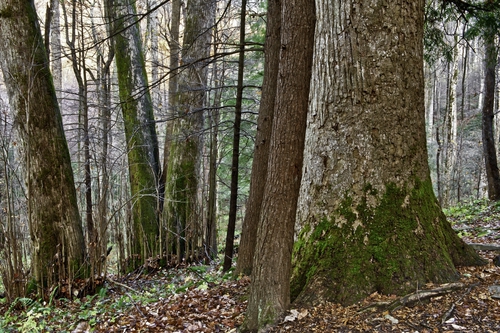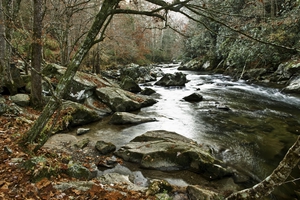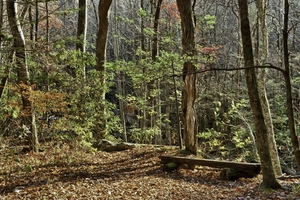In the heart of the Smokies
by REBECCA BAILEY
Photographs by CURT GIVEN/GIVEN PHOTOGRAPHY
Autumn Hardwood Forest, Copyright © Curt Given 2011Okay, you’ve arrived at your long anticipated visit to one of our gorgeous national parks. You may have somewhat of an idea of the areas you want to check out, but know you can’t cover all of them. How can you go deeper than what the tour books tell you? Those were my exact thoughts during my visit to Great Smoky Mountains National Park. I knew I wanted to know this very old and wild park. It wasn’t as much about where to go and what to see, but how to really feel the essence of its beauty. So I organized my explorations through walking, driving, photographing, writing, discovering, and best of all, playing.
Walk

Cove Hardwood Nature Trail, Great Smoky Mountains National Park
The serenity of any old-growth forest walk is incredible, but a walk through a hardwood forest is equivalent to a day at the spa with its open feel and soft play of light. The Cove Hardwood Nature trail offers a beautiful old-growth experience.
As you first follow the trail, the surrounding vegetation seems chaotic, kind of messy, but the farther you walk and the closer you look, it soon becomes obvious that you are in a well-nourished, thriving forest. Underneath the littered floor of leaves, moss covered rocks and low-growing ferns, lies rich soil with a mass of important microorganisms.
Every turn brings something new. The trail crosses a creek that tumbles down the sloped hillside, pooling and bubbling around giant flat rocks. Along the way, pileated woodpeckers excavate bugs from giant snags and squirrels chatter, climbing up and down the mix of old and young trees. Thriving rhododendrons cluster along the slopes and are dwarfed by giant groves of hardwoods. Downed trees and decaying nurse logs provide shelter and nourishment to a diversity of plant species in various stages of life.
A variety of giant trees are found in these types of cove hardwood forests including tulip tree, yellow buckeye, brasswood and silverbell to name a few. This trail is a great place for identifying them. The visitor center has an inexpensive tree and forest guide that can help.
For a longer and more challenging old growth hike, try the Ramsey Cascade trail that is located in the Greenbrier area of the park. Where ever you choose, I promise that beauty and peace will prevail.
Drive
Many parks have short scenic auto tours designed to highlight specific areas. In the Smokies, the Roaring Fork auto tour is outstanding. What was once an old wagon trail to the Roaring Fork community is now a 5.5 mile one-way road that winds through a forest of cove hardwoods. The slow speed, narrow lane and lush vegetation make it feel more like a walk than a drive. It twists and turns, ascends and descends, follows a creek and opens to wonderful mountain vistas. Surprising bursts of color are everywhere.

Historic cabin, Roaring Fork auto tour, Great Smoky Mountains National Park
It’s also a great place to get a sense of the park’s human history. Remains of early homesteads built from the mid 1800s to the early 1900s are scattered throughout the area. You can wander through them and with the help of interpretive signs, come away with a good understanding of what life was like for early settlers of this tiny community. Near the end of the lane an old mill is still standing. The man who owned the mill was somewhat of an entrepreneur for his time. You can read all about him and others in an auto tour guide available for a dollar at the Park Headquarters.

Little River, Great Smoky Mountains National Park
In short, anywhere in the Smokies is fantastic for photographs. An especially scenic area is the Little River road that starts at the visitor center and heads toward Cades Cove. The road parallels the Little River and has many pullouts with something interesting to photograph at every one. Pretty rocks and huge boulders interrupt the river’s flow creating beautiful cascades. A variety of trees and hills on either side of the river and its rushing sound make it easy to forget that the road is only fifteen feet away. That’s a perk if you have lots of heavy camera gear to haul. You can easily spend a morning driving along this road taking pictures. And it’s a fabulous way to go deeper—see things in a new way. Isolate that one gorgeous tree among many or find the perfect composition of rushing water, rocks and boulders for your vacation album.
Middle Prong of Little Pigeon River, Great Smoky Mountains National Park,
For me, a big part of any experience is to write about it, but you definitely do not need writing talent to do this. You can journal or jot a few field notes. It's for your eyes only. I encourage it to deepen your experience. The idea is to find a place to relax, write a few notes about some of the interesting things you are seeing and experiencing, while soaking in all of the natural beauty surrounding you. I found just the spot in the Greenbrier area. It was a little off the beaten path, with fewer visitors, making it perfect for a few minutes of writing.
The Greenbrier road follows Little Pigeon river and just before you cross a wooden bridge, Little Pigeon and Middle Prong of Pigeon River meet. At this point just a couple of feet below the road, two giant flat rocks form a kind of chair for sitting. The sound of the flowing water is soothing, calming thoughts and bringing everything into focus. Problems seem to dissolve naturally. The spot is surrounded by trees and big river rocks create cascading water.
Now scientists will tell you that the negative ions generated from cascading water in this river are what makes you feel good. Your mood is better, energy is higher, and your physical strength is improved. But, I like to think of my improved mood more in terms of the gratitude that I feel for all of the wonder and beauty that nature has to give us.
Discover
Autumn Hardwood Forest, Great Smoky Mountains National Park, © Curt Given/Given Photography 2011Learning something new or maybe seeing something old in a new way, always adds an exciting element to any park visit. I approach it like a treasure hunt. Being a native Pacific northwesterner has not given me much exposure to hardwood forests. So for me, the trees in this park were my treasure. I bought an identification pamphlet in the park visitor center and throughout our wanderings searched for trees with great names such as sassafras, scarlet oak, silverbell, tuliptree and sweetgum. It was somewhat challenging because most of the leaves were on the ground, but I did leave with much more knowledge about the makeup of a hardwood forest.
Play

Hardwood Forest, Great Smoky Mountains National Forest, © Curt Given/Given Photography 2011I marched, stomped, and kicked my way through piles and piles of leaves! In some places they were three inches deep. I even tossed them in the air, made a beautiful leaf collage on a big flat rock, and floated them down a creek. And the fragrance...oh that wonderful earthy fragrance!
____________________________
You might also enjoy reading Get up-close and personal with wildlife.











